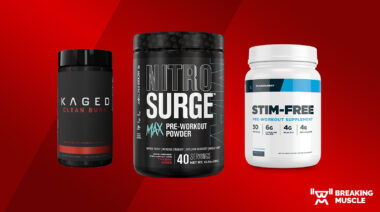Whether you are relatively new to the fitness scene, or a seasoned powerlifter or bodybuilder, odds are that you have heard of creatine. It is also likely you have heard both good and bad things about this notorious supplement. The purpose of this article is to provide information on creatine, its efficacy and/or benefits, the types of creatine available, some debunking of media propaganda, and proper dosing protocols.
What Is Creatine?
I am sure even the biggest couch potato has at least heard of the word creatine. But what is it? The word creatine is derived from the Greek word for meat, and was first discovered by a French scientist by the name of Michel Chevreul in the 1800s.5
Creatine is a naturally occurring nitrogenous organic acid found in the skeletal muscle of vertebrates. About 95% of the creatine found in the human body is located within the skeletal muscle. Creatine is produced from amino acids, L-arginine, glycine, and L-methionine to be exact, and the process is performed mainly in the kidneys and liver.2
Most of the creatine found in our bodies comes from the foods we eat. Unless you are a vegetarian, up to half of the creatine that is stored in your body can come from meat.5
Benefits Of Creatine Supplementation
Without getting too scientific and technical, creatine is stored in the muscles and is used as a form of energy called phosphocreatine. Phosphocreatine is associated with power output in prolonged muscle use. When this is depleted within the muscle, muscle fatigue is triggered. Increasing creatine within the body has been proven to help increase phosphocreatine output during anaerobic activity. This is known as the ATP-CP energy system within the body.6
As briefly touched upon, increasing the creatine content within the muscles helps prolong the depletion of phosphocreatine. This in short means an increase in muscular endurance, as well as an increase in strength and power.6
Another benefit of creatine is that it helps muscles look fuller due to the fact it actually draws water within muscle cells, increasing the volumization of muscles. This has shown to have quite beneficial anabolic effects, since it increases protein synthesis. The increase in the volume of the muscle cell signals that it has grown. Consequently, that muscle cell responds by increasing its production of vital proteins, or simply put, an increase in the efficiency that protein is utilized.4
Creatine has also been shown to buffer lactic acid build up. This means the “burn” you feel during a given exercise may not be as intense, or may be blunted, possibly resulting in more reps.3
Types Of Creatine
Since creatine was discovered in the fitness world as a beneficial supplement, supplement companies have been trying to manipulate the chemical structure to produce a better version. While there are brief studies that show some newer versions tend to be slightly absorbed better than the original version, creatine monohydrate, which was first introduced by EAS in 1993, the exorbitant costs these companies are charging for these “super creatines” is probably not worth it.
Without getting into detail of the advantages/disadvantages of each, below are a few examples of available creatines today. Keep in mind creatine monohydrate has been proven time and time again as safe and effective, and supplement companies are constantly trying to “reinvent the wheel” so to speak in order to make money with the reintroduction of various types of creatine.1
- Monohydrate
- Ethyl Ester
- Tri-Creatine Malate Buffered
- Creatine Liquid
Creatine And In The Media
As with anything that yields results, the media has placed blame on creatine for some bad things that have happened to athletes over the last few years. There are countless studies, articles, etc. to debunk some of the propaganda the media associates with creatine, which are mainly kidney issues. Here is a summary taken from a study posted on T- Nation.
The research unequivocally states that creatine is safe in the measured parameters (7, 12, 15, 20, 22, 23), although some people are quick to point out that no long-term studies (i.e. 10+ years) have been performed. Interestingly, so much research on safety has come out in the last few years that a couple of complete literature reviews have been performed on the topic (1, 31). For those who question the long-term effects on kidney and liver function, we have to think that if five straight years of use has zero negative effect, then the negative effect we’re waiting for just won’t ever happen.
One thing to also note, any time athletes suffer from dehydration, the media is quick to blame creatine. They often quote high levels of creatine were found in tests in individuals who suffered dehydration. First off, creatine cannot be detected in a user through tests, meaning it is virtually impossible to detect if someone is supplementing creatine. Moreover, the media often mistakes creatine with creatinine, which is a totally different substance that will be elevated due to dehydration. Creatinine is not creatine, but a breakdown product of creatine within skeletal muscle.
There is no proof to show creatine dehydrates an individual, and in fact, the facts state otherwise. A study posted on T-Nation quoted from Dr. Richard Kreider:
We did several studies back in the mid-90’s that measured and monitored injuries, cramping issues, heat illness, fluid shifts, etc. The studies generally showed that there was no negative effect at all from creatine usage or there was a slight hyper-hydration where you have some fluid retention, so core temperature is lower when exercising — a benefit. Athletes using creatine actually had lower instances of cramping.
There are literally thousands of cases, studies, etc. on creatine’s safety, but the ones posted are just examples of some that can aid in getting rid of the negative connotation that often accompanies creatine.8
How Should Creatine Be Dosed?
Not much has changed in the method of dosing creatine in the last decade. Some people choose to go through a “loading phase” which is in fact just that. Basically it saturates the muscles quicker, and the effects are believed to be seen at a faster rate. The loading phase usually consists of five days, supplementing about 20 grams per day. Each dose should be about 5 grams, and doses should be spread throughout the day. After the “loading phase,” supplementing 5-10 grams per day is shown to produce optimal results.7
Many people choose to cycle creatine as well. As with anything, the body can become accustomed to it over time and it can lose its efficacy. Consequently, it is common to take creatine for 8-12 weeks, followed by a break of 8-12 weeks. The process can be repeated. Cycling is optional, but is a common practice.
Another common practice proven to be effective is to supplement creatine with a simple carbohydrate such as grape juice. The simple carbohydrates help create an insulin spike, and this helps deliver the creatine to the muscles at a much faster rate for quicker and more efficient absorption.
Also keep in mind, due to its nature creatine is most effective when staying fully hydrated. It will not be beneficial if you are not drinking plenty of water.7
Conclusion
If you are looking for a safe, proven, effective supplement to help you get that extra rep in the gym, then creatine is for you. Keep in mind, creatine is simply a supplement, which means it should supplement a good diet and training routine; there is no supplement that can replace either. However, if both are spot on, you can expect a nice boost from this naturally occurring supplement.
References:
1. Barr, David. “T NATION | Creatine Controversy.” T NATION | The Intelligent and Relentless Pursuit of Muscle. 27 Sept.
2005. Web. 16 Sept. 2010.
2. “Creatine – MayoClinic.com.” Mayo Clinic Medical Information and Tools for Healthy Living – MayoClinic.com. 1 June 2010. Web. 20 Sept. 2010.
3. “Creatine, Creatine Everywhere and No Objective Information Anywhere!” Absolute Creatine. 2006. Web 27 September
2010.
4. Creatine Monohydrate: Creatine Supplement Facts, Side Effects and Benefits. Web. 27 Sept. 2010.
5. “Creatine.” Wikipedia, the Free Encyclopedia. Web. 27 Sept. 2010.
6. Flanagan, Eamonn. “Creatine Monohydrate Supplementation – A Literature Overview.” Web. 23 Sept. 2010.
7. Flannagan, Eamonn. “Creatine Monohydrate Supplementation Practical Applications.” Web. 23 Sept. 2010.
8. Shugart, Chris, and Richard Kreider. “T NATION | The Truth About the Media Creatine Scare.” T NATION | The Intelligent and Relentless Pursuit of Muscle. 2 Sept. 2010. Web. 24 Sept. 2010.






